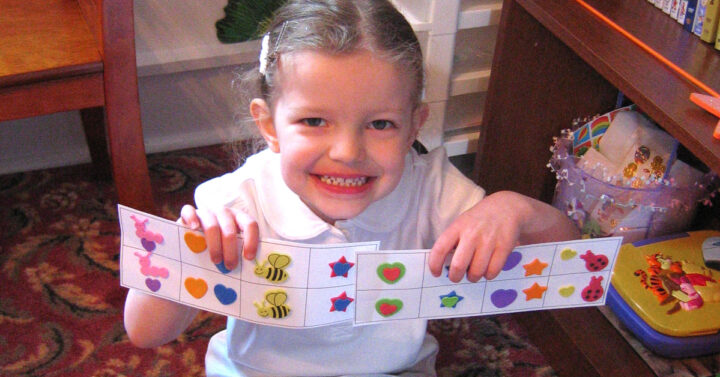While working on a project for a client, I came across this article: The School Day of the Future is Designed by Sandy Speicher. I thought it made several great points. The project is for a client who runs private schools that fit perfectly with what the author is discussing.
But what I personally found compelling is that in the process of making her argument, Speicher articulates all the reasons for homeschooling. Here are a few quotes:
Elliot Eisner, one of my favorite education professors, often asked the question, “If aliens landed on our planet and walked into our schools, what would they think the school is meant for?” We’d brainstorm: Learning to sit in rows? Learning to get up and move en masse at the sound of a bell? Learning to stay in place for 40-minute increments? Learning to override your bodily functions? Learning to answer the questions that the person standing in front of the room already knows the answer to? It’s hard not to realize that a school, upon pure observation, looks like a training ground for behavioral management.
and
One thing to keep in mind, of course, is that not every child is starting in the same place, and not every child is headed toward the same place. Some need freedom in order to learn. Some need structure. Some need a mix. But all need respect for their individuality, trust in their abilities to succeed, and adults who have the foresight to design experience to bring out individual greatness.
and
All of these innovative models are showing us that incredible results, and experiences are possible when we design the school day with the needs of the student in mind. The historic “one-size-fits-all” model of set periods of time with groups of somewhere between 20-30 kids lined up in rows and one teacher in the front of the room orchestrating the conversation…. well, Sage on Stage, Chalk and Talk, and Spray and Pray might just have met their match.
The school day of the future will be unpredictable, inconsistent, and designed to be wildly relevant for the learner, their engagement, and their development.
I definitely am not going to argue with Speicher about the ineffectiveness of the current classroom model. I strongly agree that personalized education is a huge improvement over what is currently going on in most classrooms. The big problem is that while all of this sounds good in theory, how in the world will public schools (and most private schools, for that matter) truly implement something like this? My client is doing this very thing and they are doing it very successfully. But the parents are paying big bucks to get this kind of one-on-one education for the child. There is simply no way most urban schools or even suburban schools can do something like this.
The schools are really stuck. I think that the desire is there among many of the leaders, teachers and students to have what this author discusses in the article. But it takes money and exceptionally gifted teachers to do what is being described. Where will the money come from when schools are facing shrinking revenues and there is zero indication this is going to change any time soon?
And, no, I don’t think any certified teacher can do this in a classroom. Not because teachers are stupid, but because many (most?) of them don’t have the skills needed to do this. You are talking about an incredible level of multi-tasking, planning, and evaluation here.
In addition, there aren’t enough hours in the day, even if you do have the money and skills. How can one teacher possibly offer this kind of education to a class of 20-30 students? He can’t. There isn’t enough time in the day. And with class sizes set to rise in many schools due to decreased funding and/or families that can’t afford private school tuition any longer, I don’t see how this can possibly be the education of the future except for some very lucky students scattered here and there across the country.
I’ve had a few moments (okay, hours) lately when I’ve felt that strong temptation to just put Caroline on a school bus this fall and be done with it. It is easy to look at it through rose-colored glasses and think that it would be so much easier to put her in school. But every time I feel that pull, God sends something like this to remind me that no matter which mode of education you choose, there is going to be tremendous sacrifice involved. And every time I look at the options and the sacrifices associated with each, I come back to homeschooling as the best option for our family.
I truly believe education is about so much more than learning to control your bodily functions until it is time for an official bathroom break. It is about so much more than spending literally hours practicing how to line up and turn in your papers the correct way. I quit teaching because school drove me nuts. I loved teaching. I hated dealing with school. What Speicher is talking about here is teaching and education at the highest level, not school. School is the very thing that will keep this from happening across the country in the future.









 Raising a Dreamer Child and Ignoring Conventional Wisdom
Raising a Dreamer Child and Ignoring Conventional Wisdom
What I had most trouble with teaching was trying to keep the children under control. They so disrespect authority now that instead of creating good lessons I would have to come up with ways to keep them under control! Yuck!
I love it when you articulate something that I have been trying to and couldn’t. 🙂 Especially where the Ellie/Coraline connection is concerned. Thanks, Amie 🙂
Last year I taught 6th grade math and science at a homeschool co-op. Even though I only had 10 students maximum, I still struggled to meet the needs of all my students. There were just too many differing ability levels and learning styles. Although I still believe homeschooling is the best option for my family, we are putting our children in public school next year (long story). I hope I can still supplement their education after school hours.
This former first grade teacher shouts “Amen!”. Don’t even get me started…..
Jenn,
You raise a really good point with the homeschool co-op. Ten students maximum who I suspect were probably pretty well behaved. And yet even that was a struggle. Can you imagine trying to do this in a classroom full of high school kids, many of whom are a management challenge?
I was just discussing this with a friend the other day. What has become of our educational system? It has all become about test scores. The teachers (or at least those in my area) have such pressure on them to produce good test scores, they can’t actually enjoy teaching. There are parents who refuse to discipline their children and believe no one else should either….those children create an atmosphere where other children can not learn. I guess it is my belief that we all have a part in this. Learning starts in the home, but I’m not so sure that it continues in the schools. (Sorry for the mini rant lol)
The article did read exactly like homeschool-at-school to me, too. Except with a lot more money for fancy technology, which somehow magically never breaks or mystifies the teacher or distracts the students from real learning.
Also I think schools are built on an industrial model for a reason: it’s the simplest and most general solution for the problem of educating a whole community’s children at one time. Economies of scale lead to mass production (and inconsistent quality in mass production leads to onerous quality-control measures like standardized testing). Individualized education is feasible for only a few of today’s schools.
I am reading this article partly as an ad for the author’s employer; her division creates educational technology and designs educational experiences and environments. I used to work in a technology-creating company with a human-centered design approach, and their spiel sounds almost familiar to me. It is very, very difficult (and expensive) to design and build new technological solutions that will actually work well in practice.
It will never able to be individualized at the current class sizes. It’s hard enough to individualize and plan for one child’s work, it’s impossible to do it for 20.
Really, the only answer is smaller class sizes for some kids. Think about it, what do they do when a child is having issues? The school will pull them out into a smaller setting, whether to reinforce math or reading or whatever. It’s obvious that smaller is better.
Some kids do fine in a regimented environment, but others need different methods. But with the way budgets are now and the revenue crunch, that is never going to happen for the majority of students unfortunately.
As much as I disagree with some of the teachers’ unions tactics, I have to say, I really feel for teachers today in the public schools anyway.
This definitely sounds like homeschooling, to me! I wonder if the author of the article realizes that this is done in many, many living rooms throughout the world as we speak?